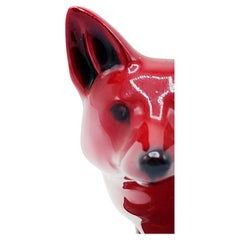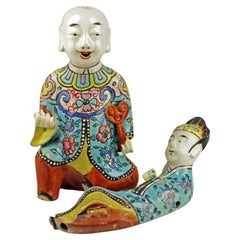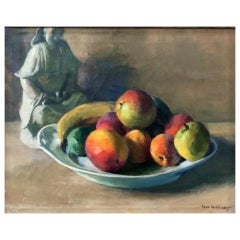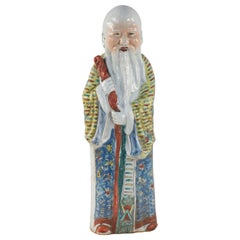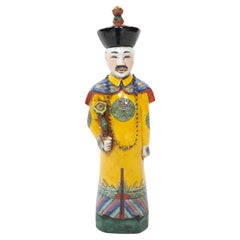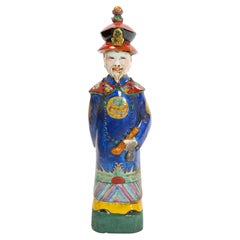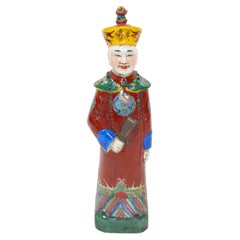Chinese Porcelain Figurines
Early 20th Century English Mid-Century Modern Porcelain
Porcelain
Antique Mid-19th Century Chinese Qing Ceramics
Enamel
Vintage 1920s American Expressionist Paintings
Canvas
20th Century Chinese Chinese Export Figurative Sculptures
Porcelain
Late 20th Century Chinese Chinoiserie Porcelain
Porcelain
Late 20th Century Chinese Chinoiserie Porcelain
Porcelain
20th Century Chinese Chinese Export Figurative Sculptures
Porcelain, Paint
20th Century Chinese Chinese Export Figurative Sculptures
Porcelain, Paint
20th Century Chinese Chinese Export Figurative Sculptures
Porcelain, Paint
Antique 19th Century Chinese Qing Ceramics
Ceramic, Porcelain, Paint
20th Century Figurines and Sculptures
20th Century Chinese Chinese Export Sculptures and Carvings
Porcelain
20th Century Chinese Chinese Export Figurative Sculptures
Porcelain
Mid-20th Century Asian Chinoiserie Ceramics
Porcelain
Late 20th Century Chinese Chinese Export Animal Sculptures
Porcelain
21st Century and Contemporary Interior Paintings
Wood Panel, Pencil, Oil
Antique 19th Century Chinese Figurative Sculptures
Porcelain
Late 20th Century Spanish Mid-Century Modern Ceramics
Porcelain
Antique 19th Century Chinese Qing Ceramics
Porcelain
Vintage 1970s Chinese Tang Animal Sculptures
Porcelain
Mid-20th Century Chinese Chinoiserie Animal Sculptures
Ceramic, Porcelain
Vintage 1950s Animal Sculptures
Porcelain, Paint
20th Century Chinese Chinese Export Figurative Sculptures
Porcelain
20th Century Chinese Chinese Export Figurative Sculptures
Porcelain
Mid-20th Century Chinese Mid-Century Modern Animal Sculptures
Porcelain
20th Century Chinese Ceramics
Porcelain
Mid-20th Century Chinese Chinese Export Sculptures and Carvings
Porcelain
21st Century and Contemporary Other Art Style Figurative Sculptures
Porcelain
2010s Sculptures and Carvings
Porcelain
Antique Early 1900s Macanese Chinese Export Animal Sculptures
Porcelain
Early 20th Century Ceramics
Porcelain
Early 20th Century Chinese Chinese Export Figurative Sculptures
Porcelain
Early 20th Century Chinese Chinese Export Ceramics
Porcelain
Early 20th Century British Animal Sculptures
Porcelain
Mid-20th Century Chinese Mid-Century Modern Animal Sculptures
Ceramic, Porcelain
21st Century and Contemporary Chinese Porcelain
Porcelain
20th Century German Chinoiserie Figurative Sculptures
Porcelain
Late 20th Century Chinese Political and Patriotic Memorabilia
Porcelain
Late 20th Century Japanese Chinoiserie Figurative Sculptures
Porcelain, Paint
Mid-20th Century Austrian Romantic Figurative Sculptures
Porcelain
Mid-20th Century Austrian Romantic Figurative Sculptures
Porcelain
Late 20th Century Chinese Ceramics
Ceramic
Mid-20th Century Chinese Chinese Chippendale Ceramics
Ceramic
Early 20th Century Chinese Chinese Export Table Lamps
Brass
20th Century Chinese Chinese Export Figurative Sculptures
Porcelain, Paint
20th Century Chinese Chinese Export Figurative Sculptures
Porcelain, Paint
20th Century Chinese Chinese Export Figurative Sculptures
Porcelain, Paint
Mid-20th Century Chinese Figurines and Sculptures
Mid-20th Century Italian Chinese Export Porcelain
Porcelain
Vintage 1960s German Chinese Export Figurative Sculptures
Porcelain
Early 20th Century Chinese Chinese Export Sculptures and Carvings
Porcelain
Late 20th Century Chinoiserie Ceramics
Porcelain
Vintage 1980s Japonisme Animal Sculptures
Porcelain
Antique 19th Century Chinese Figurative Sculptures
Porcelain
1990s Japonisme Animal Sculptures
Porcelain
20th Century Chinese Hollywood Regency Sculptures
Early 20th Century Chinese Chinese Export Figurative Sculptures
Ceramic
20th Century British Hollywood Regency Figurative Sculptures
Porcelain
Antique Late 19th Century Chinese Figurines and Sculptures
Antique 19th Century Chinese Figurines and Sculptures
- 1
Chinese Porcelain Figurines For Sale on 1stDibs
How Much are Chinese Porcelain Figurines?
- What are Chinese figurines?1 Answer1stDibs ExpertOctober 7, 2020
Chinese figurative sculptures vary widely depending on the medium and intended use. Ornate Buddhist figures assisted ritual meditation, wooden ancestor figures embodied the lingering spirit of a relative, ceramic mingqi burial figures accompanied one’s spirit in the afterlife, and decorative export sculptures presented an idealized version of Chinese culture and beauty.
 Lotus GallerySeptember 23, 2020
Lotus GallerySeptember 23, 2020Most figurines just need a light dusting every once in a while. For a deeper cleaning to remove residue (such as nicotine or adhesives), try soaking in warm soapy water and gently washing with a soft cloth.
- 1stDibs ExpertApril 5, 2022One type of Chinese figurines that is quite popular is shekwan or mudware. These small handmade figurines are often called mudmen and are, not surprisingly, crafted out of mud. In the early 1950s, a new era of mudman figurines began but these are not made individually and by hand. On 1stDibs, find authentic shekwan pieces from some of the world’s top sellers.
- 1stDibs ExpertApril 5, 2022The difference between porcelain and ceramic figurines is the materials used to produce them. Porcelain is a delicate white material, while ceramic tends to be heavier and varies in color depending on the type of clay used to produce it. Shop a wide range of antique and vintage figurines on 1stDibs.
- 1stDibs ExpertApril 5, 2022One thing to look for in an antique porcelain figure is to look for the maker’s mark, usually found on the bottom of the piece. The porcelain figure will also have a delicate fragile quality to it. On 1stDibs, find a collection of antique porcelain figures from some of the world’s top sellers.
- 1stDibs ExpertApril 5, 2022The term ceramic is a generic term that refers to something that is made of clay and solidified through heat. Porcelain falls under the ceramic umbrella, but it incorporates kaolin as an ingredient, creating a white clay. To determine if a figurine is porcelain or stoneware or earthenware, it’s best to examine it. Porcelain is somewhat translucent with a glasslike surface where there is no glaze. Shop a range of antique and vintage porcelain figurines on 1stDibs.
- 1stDibs ExpertSeptember 9, 2024To tell vintage porcelain figurines apart from other pieces, look on the bottom for a maker's mark. Then, consult trusted online resources to determine the approximate time when the manufacturer produced pieces similar to yours. It is vintage if your figurine was manufactured between 20 and 99 years ago. Older figurines are antique, while newer ones are contemporary. A certified appraiser or knowledgeable dealer can also assist with the dating and identification process. Shop a wide range of vintage figurines on 1stDibs.
 Lotus GallerySeptember 23, 2020
Lotus GallerySeptember 23, 2020Chinese figurines come in all shapes and sizes. Most figures measure between 4” and 18” tall, with some being as small as 1” in height or as large as 36” (or more) in height
 Lotus GallerySeptember 15, 2020
Lotus GallerySeptember 15, 2020Chinese porcelain can usually be dated by form and decoration. However, copies and forgeries abound, so you should have an expert such as an appraiser, reputable dealer or auction house, or museum examine your porcelain to accurately date it.
- What is Chinese porcelain called?2 Answers
 PAGODA REDOctober 7, 2020
PAGODA REDOctober 7, 2020True porcelain ware was developed in the 11th century at the imperial kilns of Jingdezhen, Jiangxi province, China. These early porcelains of the Song and Yuan dynasties are known as Qingbai or Yingqing ware, defined by a light blue-grey glaze. Later forms of Chinese porcelain include blue and white underglaze ware, Celadon ware, Jun ware, Famille Verte ware, Wucai (Five Color) ware, and Dehua ware, also known as Blanc de Chine.
 Lotus GalleryMarch 17, 2021In China, porcelain is referred to a "cíqì" 瓷器.
Lotus GalleryMarch 17, 2021In China, porcelain is referred to a "cíqì" 瓷器. - 1stDibs ExpertApril 5, 2022A Chinese porcelain pillow is a type of ceramic object produced by Chinese artisans. They normally have highly decorative rectangular designs and feature curved tops. Historically, they functioned as headrests, but today they normally serve purely as decorations. On 1stDibs, shop a wide variety of Chinese porcelain ware.
- 1stDibs ExpertApril 5, 2022Chinese Canton porcelain is a type of decorative hand-painted ceramic ware produced during the 18th, 19th and 20th centuries in China. Its name comes from the region where it originated. You will sometimes see it referred to as Cantonese porcelain. On 1stDibs, find a selection of Chinese Canton porcelain.
- 1stDibs ExpertMarch 22, 2022No, every Fornasetti porcelain figurine is handmade. In fact, the brand produces all of their home decorative items by hand at their workshop in Milan, Italy. If you see indications that a figurine came from a factory, it is likely not an authentic Fornasetti. Shop a collection of expertly vetted Fornasetti on 1stDibs.
 Lotus GallerySeptember 23, 2020
Lotus GallerySeptember 23, 2020The best way to know is to take it to an expert, such as an appraiser, reputable dealer or auction house, or museum
- 1stDibs ExpertApril 5, 2022Chinese blue and white porcelain is the most common type of decorated porcelain. Its name in Chinese is qinghua. On 1stDibs, you’ll find a collection of antique and modern Chinese blue and white porcelain from some of the world’s top sellers.
- 1stDibs ExpertApril 5, 2022Chinese Kangxi porcelain was popular because of its particular blue colorings. The blue was made using cobalt ore which was imported from Persia. As cobalt ore was a scarce ingredient, the rarity made the porcelain items highly sought after. Shop a collection of Chinese Kangxi porcelain from some of the world’s top sellers on 1stDibs.
- 1stDibs ExpertApril 5, 2022To identify Chinese export porcelain, first look for a mark. Most pieces made after 1891 feature a maker's mark that you can research using authoritative online resources. Identifying older porcelain ware is more difficult. A licensed appraiser can provide assistance. You'll find a range of expertly vetted Chinese export porcelain on 1stDibs.
- 1stDibs ExpertApril 5, 2022You can sell old Chinese porcelain in a few ways. You can advertise the piece locally or work with an antique shop or auction house. There are also reputable online platforms available for selling online. Shop a collection of Chinese porcelain on 1stDibs.
- 1stDibs ExpertAugust 20, 2024To identify Chinese porcelain marks, consult trusted online resources. Most markings on Chinese porcelain consist of four to six characters, and the last two often represent when a piece was produced. Since there is a lot of variation in the markings, looking at images shared on trustworthy websites is the best way to make an identification. Alternatively, you can use the services of a certified appraiser or knowledgeable antique dealer. On 1stDibs, explore a wide range of Chinese porcelain.
 PAGODA REDOctober 21, 2020
PAGODA REDOctober 21, 2020For thousands of years, China’s court-sponsored porcelain industry has been at the forefront of technical innovation and aesthetic refinement. Exquisite finishes and precision of form gave China an international reputation for fine ceramic wares. Age, shape, glaze, motif, and reign mark are all factors contributing to the value of a ceramic piece, indicative of the maker and the dynastic reign under which the object was created.
